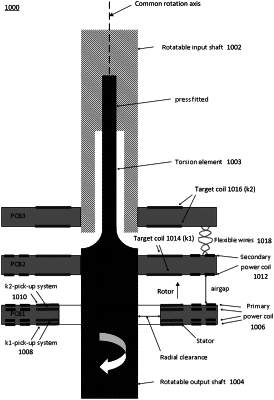| CPC G01L 3/105 (2013.01) [G01B 7/30 (2013.01); G01D 5/20 (2013.01); G01D 5/2006 (2013.01); G01D 5/2053 (2013.01); G01L 5/0042 (2013.01); G01L 5/26 (2013.01)] | 24 Claims |

|
1. A torque sensor, comprising:
rotor circuitry including a first target coil and a second target coil, the first target coil and the second target coil each configured to be disposed coaxially about a torsion element and to rotate with respect to one another to form a torsion angle in response to rotation of the torsion element when torque is transmitted, the first target coil having a k-fold rotational symmetry of a first periodicity, and the second target coil having a k-fold rotational symmetry of a second periodicity that is different than the first periodicity; and stator circuitry including a first pickup coil system having two first pickup coils configured to be disposed coaxially about the torsion element, and a second pickup coil system having two second pickup coils configured to be disposed coaxially about the torsion element, the two first pickup coils having a k-fold rotational symmetry that is the same as the first periodicity, and the two second pickup coils having a k-fold rotational symmetry that is the same as the second periodicity,
wherein the stator circuitry is configured to calculate the torsion angle based upon signals induced in the two first pickup coils via inductive coupling with the first target coil and based upon signals induced in the two second pickup coils via inductive coupling with the second target coil,
wherein each of the first target coil and the second target coil are astatic coils, and wherein the k-fold rotational symmetry of the first periodicity being different than the k-fold rotational symmetry of the second periodicity reduces mutual coupling between the first target coil and the second target coil.
|